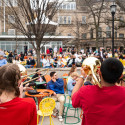Colleagues recall legacy of UW artist James Watrous
Former UW–Madison students and colleagues of artist James Watrous recalled him this week as a knowledgeable teacher and tireless arts advocate.
Watrous, who was associated with UW–Madison for nearly seven decades, died Tuesday at the age of 90.
 James Watrous |
Watrous may be best known for his murals of scenes featuring mythical logger Paul Bunyan that adorn the walls of the UW–Madison Memorial Union. Watrous painted the murals in 1933-36.
He also led a campaign to create a campus art museum to preserve and display the UW’s art collection, not only advocating for the museum but calling on alumni and others to help pay for it. “It was irresponsible for the university to accept gifts of art and not build a professional setting for them,” Watrous said in explaining his advocacy in a 1991 retrospective interview with Wisconsin Week, a university newspaper.
The resulting Elvehjem Museum of Art was dedicated in 1970. “He really led the charge for the Elvehjem,” recalled Raymond Gloeckler, an emeritus professor of art who studied under Watrous as a graduate student. “I can’t think of anyone more responsible for the Elvehjem than Jim was.”
Watrous earned bachelor’s, master’s and doctoral degrees from UW–Madison and joined the faculty in 1935. He remained active in university arts issues and activities after his retirement in 1976.
Among other books, he wrote “The Craft of Old-Masters Drawings,” published by the University of Wisconsin Press in 1957, and “A Century of American Printmaking” (UW Press, 1980).
As a UW instructor, Watrous taught popular courses that specialized in the “how” of art history. Gloeckler recalled that in Watrous’ courses, students duplicated the tools and materials used by artists through history.
Emeritus art professor John Wilde shared a Bascom Hall studio with Watrous in the late 1940s when Wilde was a graduate student. Wilde took his first art class with Watrous, a drawing course, as a freshman. He recalled Watrous as a high-spirited artist who profoundly influenced Wilde’s career.
“It changed my life. He was a mentor in the best sense of the word,” said Wilde, who kept close ties with Watrous over 61 years. The two last talked a week ago when Wilde inquired about restoring a painting.
UW–Madison has been working this year to restore the Watrous murals in the Paul Bunyan room on the ground floor of Memorial Union. After 66 years, it’s the first major touchup for the paintings.
Other Watrous works on campus include a 12-by-20-foot colored glass mosaic in Memorial Library; “Freedom of Communication,” the Vilas Hall mosaic familiar to passersby on University Avenue; and mosaics inside Ingraham Hall and the Social Science building.
Watrous’ survivors include his wife, Peg, two sons and a daughter. No funeral service is planned.



